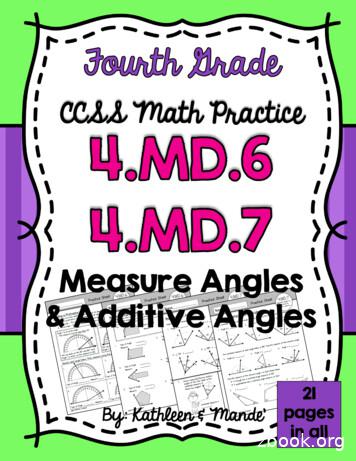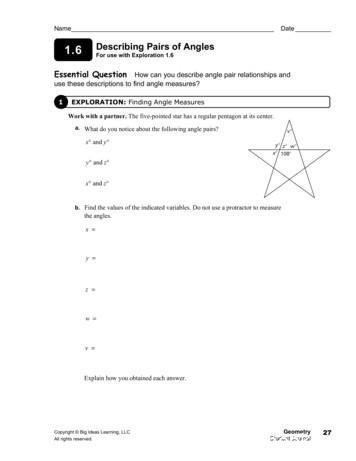Measuring And Constructing Angles Measuring And .
Measuringand1-31-3 Measuring and Constructing AnglesConstructing AnglesWarm UpLesson PresentationLesson QuizHoltHoltMcDougalGeometryGeometry
1-3 Measuring and Constructing AnglesWarm Up1. Draw AB and AC, where A, B, and C arenoncollinear.Possible answer: ABC2. Draw opposite rays DE and DF.FSolve each equation.3. 2x 3 x – 4 3x – 5 180 314. 5x 2 8x – 10 4Holt McDougal GeometryDE
1-3 Measuring and Constructing AnglesObjectivesName and classify angles.Measure and construct angles and anglebisectors.Holt McDougal Geometry
1-3 Measuring and Constructing AnglesVocabularyanglevertexinterior of an angleexterior of an anglemeasuredegreeacute angleHolt McDougal Geometryright angleobtuse anglestraight anglecongruent anglesangle bisector
1-3 Measuring and Constructing AnglesA transit is a tool for measuring angles. It consistsof a telescope that swivels horizontally andvertically. Using a transit, a survey or can measurethe angle formed by his or her location and twodistant points.An angle is a figure formed by two rays, or sides,with a common endpoint called the vertex (plural:vertices). You can name an angle several ways: byits vertex, by a point on each ray and the vertex,or by a number.Holt McDougal Geometry
1-3 Measuring and Constructing AnglesThe set of all points between the sides of theangle is the interior of an angle. The exteriorof an angle is the set of all points outside theangle.Angle Name R, SRT, TRS, or 1You cannot name an angle just by its vertex if thepoint is the vertex of more than one angle. In thiscase, you must use all three points to name theangle, and the middle point is always the vertex.Holt McDougal Geometry
1-3 Measuring and Constructing AnglesExample 1: Naming AnglesA surveyor recorded the angles formed by atransit (point A) and three distant points, B,C, and D. Name three of the angles.Possible answer: BAC CAD BADHolt McDougal Geometry
1-3 Measuring and Constructing AnglesCheck It Out! Example 1Write the different waysyou can name the anglesin the diagram. RTQ, T, STR, 1, 2Holt McDougal Geometry
1-3 Measuring and Constructing AnglesThe measure of an angle is usually givenin degrees. Since there are 360 in a circle,one degree isof a circle. When you usea protractor to measure angles, you areapplying the following postulate.Holt McDougal Geometry
1-3 Measuring and Constructing AnglesYou can use the Protractor Postulate to help youclassify angles by their measure. The measure ofan angle is the absolute value of the difference ofthe real numbers that the rays correspond with ona protractor.If OC corresponds with cand OD corresponds with d,m DOC d – c or c – d .Holt McDougal Geometry
1-3 Measuring and Constructing AnglesHolt McDougal Geometry
1-3 Measuring and Constructing AnglesExample 2: Measuring and Classifying AnglesFind the measure of each angle. Then classifyeach as acute, right, or obtuse.A. WXVm WXV 30 WXV is acute.B. ZXWm ZXW 130 - 30 100 ZXW is obtuse.Holt McDougal Geometry
1-3 Measuring and Constructing AnglesCheck It Out! Example 2Use the diagram to find the measure of eachangle. Then classify each as acute, right, orobtuse.a. BOAm BOA 40 BOA is acute.b. DOBm DOB 125 DOB is obtuse.c. EOCm EOC 105 EOC is obtuse.Holt McDougal Geometry
1-3 Measuring and Constructing AnglesCongruent angles are angles that have the samemeasure. In the diagram, m ABC m DEF, so youcan write ABC DEF. This is read as “angle ABCis congruent to angle DEF.” Arc marks are used toshow that the two angles are congruent.The Angle Addition Postulate isvery similar to the SegmentAddition Postulate that youlearned in the previous lesson.Holt McDougal Geometry
1-3 Measuring and Constructing AnglesHolt McDougal Geometry
1-3 Measuring and Constructing AnglesExample 3: Using the Angle Addition Postulatem DEG 115 , and m DEF 48 . Find m FEGm DEG m DEF m FEG Add. Post.115 48 m FEGSubstitute the given values.–48 –48 Subtract 48 from both sides.67 m FEGSimplify.Holt McDougal Geometry
1-3 Measuring and Constructing AnglesCheck It Out! Example 3m XWZ 121 and m XWY 59 . Find m YWZ.m YWZ m XWZ – m XWY Add. Post.m YWZ 121 – 59 Substitute the given values.m YWZ 62 Subtract.Holt McDougal Geometry
1-3 Measuring and Constructing AnglesAn angle bisector is a ray that divides an angleinto two congruent angles.JK bisects LJM; thus LJK KJM.Holt McDougal Geometry
1-3 Measuring and Constructing AnglesExample 4: Finding the Measure of an AngleKM bisects JKL, m JKM (4x 6) , andm MKL (7x – 12) . Find m JKM.Holt McDougal Geometry
1-3 Measuring and Constructing AnglesExample 4 ContinuedStep 1 Find x.m JKM m MKLDef. of bisector(4x 6) (7x – 12) 12 12Substitute the given values.Add 12 to both sides.4x 18Simplify.–4x 7x–4x18 3x6 xHolt McDougal GeometrySubtract 4x from both sides.Divide both sides by 3.Simplify.
1-3 Measuring and Constructing AnglesExample 4 ContinuedStep 2 Find m JKM.m JKM 4x 6 4(6) 6Substitute 6 for x. 30 Simplify.Holt McDougal Geometry
1-3 Measuring and Constructing AnglesCheck It Out! Example 4aFind the measure of each angle.QS bisects PQR, m PQS (5y – 1) , andm PQR (8y 12) . Find m PQS.Step 1 Find y.Def. of bisectorSubstitute the given values.5y – 1 4y 6y–1 6y 7Holt McDougal GeometrySimplify.Subtract 4y from both sides.Add 1 to both sides.
1-3 Measuring and Constructing AnglesCheck It Out! Example 4a ContinuedStep 2 Find m PQS.m PQS 5y – 1 5(7) – 1Substitute 7 for y. 34 Simplify.Holt McDougal Geometry
1-3 Measuring and Constructing AnglesCheck It Out! Example 4bFind the measure of each angle.JK bisects LJM, m LJK (-10x 3) , andm KJM (–x 21) . Find m LJM.Step 1 Find x. LJK KJM(–10x 3) (–x 21) x x–9x 3 21–3–3–9x 18x –2Holt McDougal GeometryDef. of bisectorSubstitute the given values.Add x to both sides.Simplify.Subtract 3 from both sides.Divide both sides by –9.Simplify.
1-3 Measuring and Constructing AnglesCheck It Out! Example 4b ContinuedStep 2 Find m LJM.m LJM m LJK m KJM (–10x 3) (–x 21) –10(–2) 3 – (–2) 21 Substitute –2 for x. 20 3 2 21 46 Holt McDougal GeometrySimplify.
1-3 Measuring and Constructing AnglesLesson Quiz: Part IClassify each angle as acute, right, or obtuse.1. XTSacute2. WTUright3. K is in the interior of LMN, m LMK 52 ,and m KMN 12 . Find m LMN.64 Holt McDougal Geometry
1-3 Measuring and Constructing AnglesLesson Quiz: Part II4. BD bisects ABC, m ABD , andm DBC (y 4) . Find m ABC.32 5. Use a protractor to draw an angle with ameasure of 165 .Holt McDougal Geometry
1-3 Measuring and Constructing AnglesLesson Quiz: Part III6. m WYZ (2x – 5) and m XYW (3x 10) .Find the value of x.35Holt McDougal Geometry
Holt McDougal Geometry 1-3 Measuring and Constructing Angles The set of all points between the sides of the angle is the interior of an angle.The exterior of an angle is the set of all points outside the angle. Angle Name R, SRT, TRS, or 1 You cannot name an angle just by its vertex if the
- Page 8 Measuring Angles: Real-Life Objects - Page 9 Draw Angles - Page 10 Draw Angles: More Practice - Page 11 Put It All Together: Measure & Draw Angles - Page 12 Joining Angles - Page 13 Joining More Than Two Angles - Page 14 More Practice: Joining Angles - Page 15 Separating Angles .
Adjacent angles are two angles that share a common vertex and side, but have no common interior points. 5 and 6 are adjacent angles 7 and 8 are nonadjacent angles. Notes: Linear Pairs and Vertical Angles Two adjacent angles are a linear pair when Two angles are vertical angles when their noncommon sides are opposite rays.
Section 1.5 Measuring and Constructing Angles 39 Measuring and Classifying Angles A protractor helps you approximate the measure of an angle. The measure is usually given in degrees. Measuring and Classifying Angles Find the measure of each angle. Then classify each angle. a. GHK b. JHL c. LHK SOLUTION a. HG ⃗ lines up with 0 on .
Vertical angles are two angles whose sides are opposite rays. Two angles are supplementary if the sum of their measures is 180. : Measuring Angles LESSON 1-6 c. complementary Two angles are complementary if the sum of their measures is 90. No pair of angles is complementary. d. adjacent b. supple
vertical angles. Vertical angles have the same measure. Vertical angles are also called opposite angles. 1 and 2 are vertical angles. 3 and 4 are vertical angles. 14. In this triangle, name a pair of complementary angles. m T 30 m L 60 30 60 90 . So T and L are complementary angles. 15. In this parallelogram, name a pair of .
Vertical Angles Words Two angles are vertical angles if they are opposite angles formed by the intersection of two lines. Vertical angles are congruent. Examples 4 2 3 1 1 and 3 are vertical angles. 2 and 4 are vertical angles. EXAMPLE 2 Finding Angle Measures Find the value of x. a. 70 x The
Adjacent Angles: Two angles and with a common side ⃗⃗⃗⃗⃗ are adjacent angles if belongs to the interior of . Vertical Angles: Two angles are vertical angles (or vertically opposite angles) if their sides form two pairs of opposite rays. Angles on a Line: The sum of the me
two acute vertical angles 62/87,21 Vertical angles are two nonadjacent angles formed by two intersecting lines. You can use the corner of a piece of paper to see that Ø ZVY and Ø WVU are less than right angles. 7KHUHIRUH DQG DUHDFXWHYHUWLFDO angles. two obtuse adjacent angles 62/87,21 Adjacent angles are two angles that lie in the same























